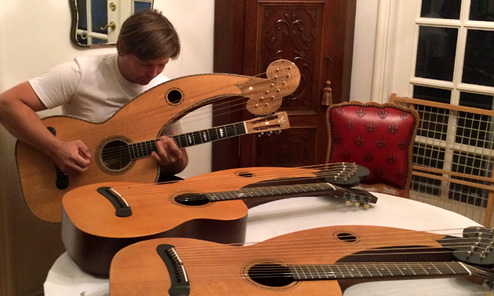By now you all know that Scott Holloway (who came to fame as the creator of the imported entry-level Holloway harp guitars) teamed up with luthier Jim Worland and set up shop in South Pasadena, California as the Dyer Harp Guitar Co. Happily, the name (now a registered trademark) appears to be in good hands. Scott has always been a fanatic about vintage Dyers, and Jim, who for years built his own varied and custom harp guitar designs, has now taken enough of them apart and built his own duplicates from scratch that he thoroughly understands them.
Case in point? Scott brought over their three latest builds last weekend, hoping to impress me. He did.
I’ve watched these develop from their first promising prototypes through the high quality instruments sent to Stephen Bennett and my brother earlier this year to these last couple, and am thrilled to be able to admit to Scott that they’ve finally nailed it.

Laid out from front to back are a standard Style 4 with orange top and mahogany b&s, an upgraded Style 4 with walnut b&s, and a beautiful upgraded Style 7 with myrtle back and sides. The mahogany is spoken for, the walnut we just listed on Harp Guitar Music, and the myrtle is going to Andy McKee who has signed on to tour with it.
An extra highlight for me is that I supplied the myrtlewood for this instrument. I may as well tell you the story: I long had a fantasy (almost but not quite a plan) to find someone to construct an identical series of Dyers (same top, etc.) but with each having a different eye candy tonewood for the back and sides. I even salted away the choicest sets that I obtained from Kerry Char, Rich Mermer and others that I sold on HGM. Some time ago, I reluctantly decided to part with the whole lot and Scott cleaned me out. He’s already built some exceedingly attractive instruments with the hondo and claro walnut; now it was the myrtle’s turn, and what a gorgeous thing it is! Very koa-like, without the golden brown hue. Tonally, also. So, while not precisely my controlled experiment, these three instruments laid out and plucked side by side on the table and in our laps gave a good representation! All were built by Jim Worland, as identically as possible and with the same Alaskan Sitka spruce tops (the 4’s being stained and lightly satin finished, the 7 being glossy finished). Each sounded very similar with surprisingly subtle but noticeable differences in color. In a blind test to try and pick a favorite, I could imagine going around in circles, undecided (and perhaps indefinitely). It gave me a sense of how my original idea might have panned out – a visual and aural varietal feast!
Hey, but enough about me…I just wanted to applaud Jim and Scott for their perseverance.
PS: Not for the first (or last) time, I bugged Scott about getting his long-gestating CD out. The guy’s a triple threat!







Bravo, Scott & Jim! I second Gregg’s assessment!